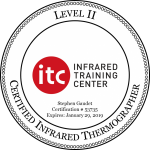In the past three months I’ve seen repeated news reports of home fires with fatalities that could have been prevented with smoke and carbon monoxide detectors installed.
If you’re unaware, Carbon monoxide (CO) is a colorless, odorless, and tasteless gas that is slightly less dense than air. It is toxic to humans and animals. Carbon monoxide poisoning occurs after enough inhalation of carbon monoxide (CO). Carbon monoxide is a toxic gas, but, being colorless, odorless, tasteless, and initially non-irritating, it is very difficult for people to detect. Carbon monoxide is a product of incomplete combustion of organic matter due to insufficient oxygen supply to enable complete oxidation to carbon dioxide (CO2). It is often produced in domestic or industrial settings by older motor vehicles and other gasoline-powered tools, heaters, and cooking equipment.
Prior to 1981 attached garages were not required to have a firewall. New standards now require at least 1/2-inch drywall (gypsum board) applied on the garage-side to separate the garage from the residence and its attic space. Garages located below a habitable room shall be separated by at least 5/8-inch Type X drywall (gypsum board) or equivalent. All open holes in drywall need to be properly sealed and taped to prevent car off gases and fire from spreading into home.
Heating your home with any type of fossil fuel you run the risk of carbon monoxide poisoning it’s that simple. These fuels include natural gas, propane, oil, kerosene, coal, wood and pellets stoves. All chimneys should be lined; otherwise they can leak within the walls of your home undetected.
This is a small example of what I’ve found while doing home inspections these past 3 months. All photos are from homes that I personally inspected.


In figures 1 and 2, we have a furnace exhaust running through a crawlspace, pipe is approximately 20 feet long. As you can see we have extensive exhaust leaks. Based on size of the holes this has been going on for quite some time. The homeowner is unaware because they never installed a carbon monoxide detector. On a side note, the furnace was been recently serviced. So what did the service technician do?
In figures 3 and 4, different house, foreclosure same problem exhaust leak in this case no serviced in quite some time. No smoke or carbon monoxide detectors present.


Figure 5, woodstove, in service homeowner unaware of exhaust leak. No carbon monoxide or smoke detector present. The home owner was still using this! Are you kidding me?

Fig 6. Home in Manchester, notice anything wrong? Ans. Hearth is too small, should extend 18” from front door to prevent any falling ashes from burning wood floor. More on wood stoves.


Fig 7, Additional problem, unlined chimney from wood stove in Fig 6 leaking creosote in attic space. This situation is begging for a chimney fire which will happen undetected, no smoke or carbon monoxide detectors installed. Keep in mind if creosote is leaking through the mortar joints carbon monoxide is also. One of the main dangers of wood burning is the excessive buildup of creosote in chimneys and stove pipes. Creosote is a gummy, foul smelling, corrosive and extremely combustible substance that, if no precautions are taken, will coat the insides of everything it passes through. It is formed when volatile gases given off in the burning process combine and condense on their way out of the chimney.

Last, woodstove installed in a mobile home resting on plywood, no fire protection whatsoever. Safe to assume the installer never pulled a permit to install it. There is a brownie pan in front to catch the ashes. No smoke or carbon monoxide detectors present anywhere in the home.

Another common problem dealing with mobile homes is propane heaters running below the unit. Owners use them to keep the pipes from freezing during winter months and assume that this is a safe practice. It’s not carbon monoxide leaks up though the flooring, reported deaths each year.
If you have a wood, gas, pellet, or coal stove have it inspected. This includes your chimney if it has not been inspected in a while. More important if you installed a wood stove without a permit I strongly suggest you get it inspected.
In conclusion, if you’re not looking to become a statistic install smoke and carbon monoxide detectors in your home. Test any installed units and replace the batteries each year.
Ideally there should be smoke detectors installed on every floor, including the basement and the attic space, inside every bedroom, and in the hallway outside the bedrooms. The detectors should be hard-wired with battery back-up.
PER NFPA- “Almost two-thirds of home fire deaths resulted from fires in homes with no smoke alarms or no working smoke alarms.” The International Association of Firefighters recommends installing photoelectric because they sense smoldering (smoke) more efficiently.





